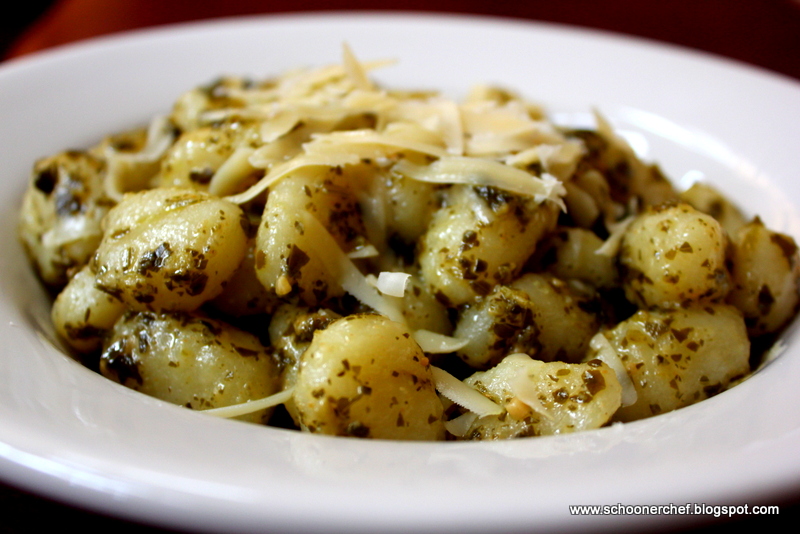Basil will be planted soon, and that gets me thinking of pesto, and that gets me thinking of potato gnocchi.
Gnocchi take a little bit of practice, but it is well worth the time and effort. The key is to treat it like pie or bisquit dough and handle it gently. This will help produce a tender pillow of pasta that begs to be dressed in just enough sauce so as not to mask it. Pesto is great and so is just a little browned butter and toasted sage leaves.
I have searched through cook books and online, have read that it must be russet potatoes or that it must never be russet potatoes and that you should only use Yukon gold. I decided to try using both and found that a combination of 3/4 russet to 1/4 Yukon gold works well. Only have russet or Yukon? No problem.
Boil or Bake? The goal is to have a dryish mass of potato. I find the russets are best baked in their jackets and then when they come out of the oven cut them in half. lengthwise, then give them a little squeeze to help release steam. The Yukon's, being a wax potato, do not mind being boiled but do keep the skins on and when the water comes to a boil reduce to a simmer. This will help keep them from splitting.
 Once the potatoes are cool enough to handle the skins are removed and the potato is passed through a ricer or a food mill. Don't have a ricer or food mill? Then mash them, but be gentle. And consider getting a ricer or food mill!
Once the potatoes are cool enough to handle the skins are removed and the potato is passed through a ricer or a food mill. Don't have a ricer or food mill? Then mash them, but be gentle. And consider getting a ricer or food mill!Now the flour and salt are added. At first it will feel as though the potato and flour are never going to mix. fear not. I use a fork to mix, trying not to mash it, more of a fold in motion. The idea is to not build up the gluten in the flour, think pie dough here.
Use as little flour as possible, adding just enough to keep the dough from being tacky. I can not stress enough the importance of keeping a light hand in working the dough. This is a good time to check the dough.
Pull off a little piece and drop it into boiling salted water. After it has come to the surface let it cook for another 15 seconds, then fish it out and taste it. Worst case scenario is that the gnocchi will fall apart in the water. This will give you the chance to add a little more flour to the remaining dough.
Now the dough is divided into fourths, and each ball of dough is rolled out into ropes, about the thickness of your thumb, and then each rope is cut into half inch or so lengths, traditionally the next step is to roll the little balls over the tines or a gnocchi board. If you have a gnocchi board but do not have a ricer I would be very surprised. The little groves are made to give more surface area for the sauce to cling to. Don't have the time or patience for this step? no worries.
The gnocchi are now ready for cooking, or they can be covered loosley and left to sit for a few hours, or you can put them on a tray, freeze them, and then place them in a freezer bag for latter use. Do not thaw before cooking.
How ever you choose to handle them, when you go to boil them, place just a handfull into the water. When they come to the surface let them cook for another 15 seconds and then remove to a warm platter and coat with a little of what ever sauce you are using. Keep warm while cooking remaining gnocchi.

No comments:
Post a Comment